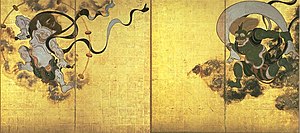Tawaraya Sōtatsu

Tawaraya Sōtatsu (俵屋宗達) (fl. early 1600s) was a Japanese artist and also the co-founder of the Rimpa school of Japanese painting. Sōtatsu began to work as a fan-painter in Kyoto. Later, he rose to work for the court as a producer of fine decorated papers for calligraphy. He was highly influenced by Kyoto’s courtly culture. Sōtatsu met the great designer and calligrapher Hon’ami Koetsu, and painted under-designs in gold and silver for his writing. Sōtatsu excelled in projects that needed careful placing of decorative screens and fans, and took this to its highest level. He pioneered a new boldness of color and line. He popularized a technique called tarashikomi, which was carried out by dropping one color onto another while the first was still wet. Sōtatsu also developed an original style of monochrome painting, where the ink was used sensuously, as if it were color. Among his best works are the illustrated covers he painted for the Lotus Sutra.
References
Gowing, L (ed.) 1995, A Biographical Dictionary of Artists, Rev. edn, Andromeda Oxford Limited, Oxfordshire.
